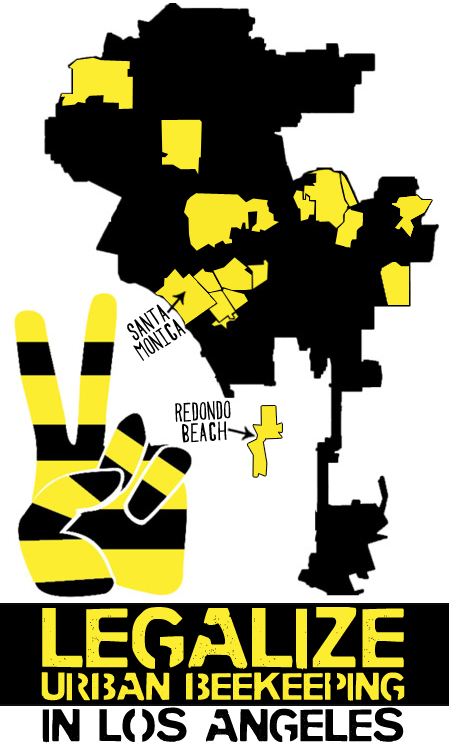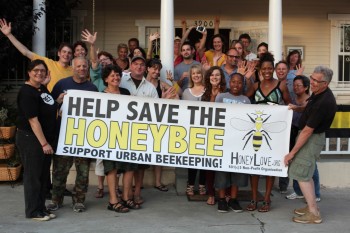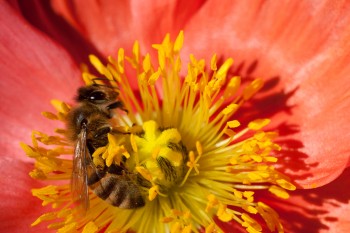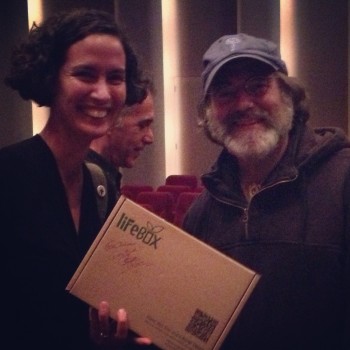
by HoneyLover Susan Rudnicki
Spring is the time of year when bees go into high gear to get ready to do their instinctive reproductive act of procreation—swarming. A colony grows to fill its space, replacement queens are drawn and nurtured, and the final event is a leaving from the mother hive of about 50% of the workers and the old queen. These bees will attempt to found a new colony somewhere else and begin the cycle again. During this build up in Spring we urban beekeepers must watch carefully for the signs of swarm preparation and guide it so that a swarm is not the outcome—in the city such swarms are not appreciated by the general public living in close proximity to us.
I have now been keeping bees almost four years and am getting a better feel for the rhythm of the growth cycle in a colony. We have mild winters in Los Angeles, so the Spring brooding up period often begins in January. This means we will begin seeing drones and drone brood, new brood comb being drawn, and a general increase in the number of bees and activity of the queen.
However, early this year, two of my hives at the house were not showing these changes and I really began to notice by February. It seemed they were just staying in a holding pattern—no new comb was being drawn and, at first, this was the most noticeable issue. By the beginning of March, I was seeing sac brood, perforated cappings (small holes in the brood caps), lots of uncapped pupae in the purple eye stage, dried up “mummies” of brood in cells, and some cells of open brood with watery goop that may have been European Foul Brood. There were also some adult bees with DWV, or deformed wing virus. The wings of the bee are twisted little stumps or thread-like and useless. The colonies had plenty of stored honey and many frames of bee bread. Together, these conditions and the different maladies of the larvae and pupae are sometimes lumped under the name “Bee Parasitic Mite Syndrome” which describes diseases vectored by the activities of the varroa mite.
Here is a website entry detailing what I was seeing—
Information compiled by Beekeeper Lonnie E. Campbell of The Loudoun Beekeepers Association.
Bee Parasitic Mite Syndrome was first named by The Beltsville Bee Lab to explain why colonies infested with both varroa mites and tracheal mites were not thriving. BPMS was first reported by European beekeepers whose colonies were already stressed by varroa mites. Colonies that are apparently very healthy and productive suddenly experience a sudden decrease in adult population often resulting in the total loss of the colony. Plenty of food stores are often present, but very spotty and unhealthy brood are observed.
I began searching my readings and books to find out what I might do to help these two formerly thriving hives (one hive is 5 mediums, the other 2 deeps and 3 mediums). I wanted to support them before their population dropped too much that they would be weakened beyond recovery. I saw on inspection March 22 that very little open brood was present and no eggs. One queen was seen (in the biggest colony) but in the other I didn’t find the queen.
Michael Bush’s book offered the best information for this situation that I could find. A brood break, or a cessation of egg laying by the queen, is one of the best responses for breaking the cycle of the pests and diseases that may afflict a hive. By denying the pathogens a food source the disease cycle is automatically broken. One way of doing this is to find and kill the queen and then introduce a new queen. Another way is to dispatch the queen and let them raise another one. By the time the new queen is laying, the brood break will have cleansed the disease cycle.
But the method I thought I would settle on was the use of a push in cage. This is a small confinement cage made out of eighth inch hardware cloth that holds the queen on the face of a frame for a period of time to prevent her laying eggs in the normal pattern. It is just a shallow 3 sided box of wire, 5 X 10 inches, pushed into the face of the wax comb. You try to place it in a zone with some honey cells, some emerging brood, and some open cells—all of these to serve the needs of the confined queen.
On March 28, after preparing two cages and getting my mind clear about what I was going to do, I opened up the first hive to start my search for the queen. I had at hand a good tool for safely catching a queen— a “hair clip” catcher.
However, I soon saw that something better than my plan had already occurred. The frames that had lacked any eggs or open brood were now completely filled with eggs! The queens had stopped laying eggs by their own accord and interrupted the brood cycle of the diseases and varroa that had been afflicting them. I was very excited that the queens and their workers seemed to have a inborn strategy to get over their problems. My notes to Michael Bush to report this were confirmed in his answer here:
Yes, the bees often do a brood break to resolve the issues. Sometimes it’s done by dispatching the old queen and sometimes she just shuts down. EFB usually clears up on it’s own when whatever stress was the cause is relieved. Usually by a flow in a dearth.
And this one:
It doesn’t always work out well, but then interfering doesn’t always work out well either.
“Our attentions may be useful to them but are oftener noxious to them; thus far goes our interference.” –Francis Huber (in a letter to Elisa)
“…without the foresight, or rather the astonishing presence of mind of the bees, who always do at the proper time what needs to be done…” –Francis Huber (in a letter to Elisa)
So, there we have it. Another beek lesson learned!

 follow
follow  watch
watch  subscribe
subscribe 

















 Become a member of HoneyLove and learn to be an urban beekeeper!
Become a member of HoneyLove and learn to be an urban beekeeper!
 Plant an organic garden without the pesticides that harm honeybees!
Plant an organic garden without the pesticides that harm honeybees!
 Provide a water source on your property – bees love clean water to drink!
Provide a water source on your property – bees love clean water to drink!